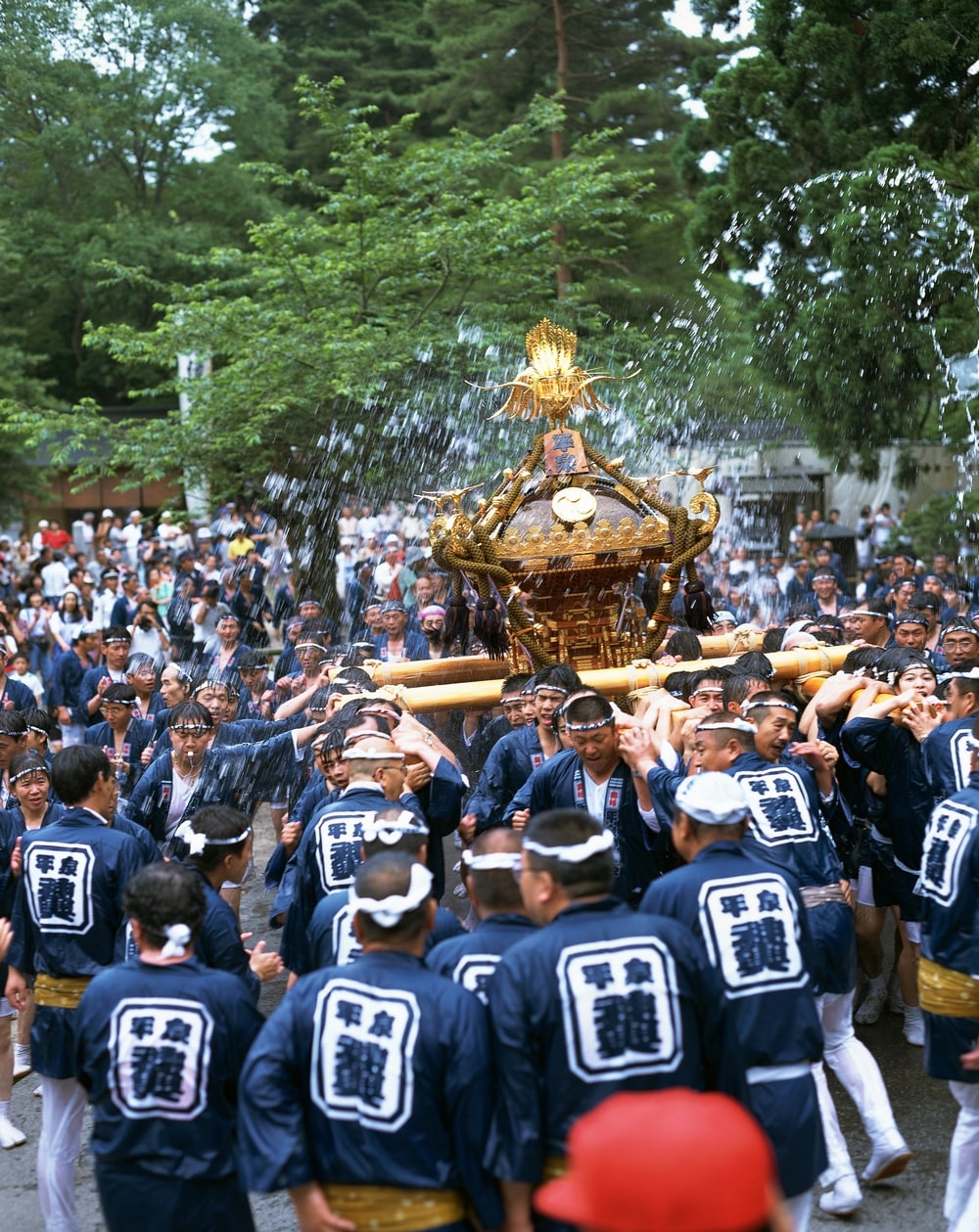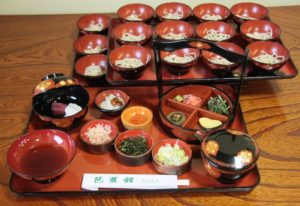平泉水かけ神輿
日本のほとんどの地域では、「お神輿」はお祭りなどで当たり前のように行われている行事です。それは、つまり、行列の中心に、「神輿」という駕籠のようなものを竹や木の担ぎ棒につけ、その担ぎ棒を行列が肩に乗せて練り歩いていきます。神輿行列は足踏みしたり、担ぎ棒を叩いたり、勇ましい声をかけあったり、時にはお神輿を前後左右に傾けたりして、威勢よく観客を楽しませます。
お神輿の由来は元々、町を見守る神様が町内を回り、幸運を各所へと導いて広がらせるための習慣でした。神様が一時的に乗ってもらうため、お神輿そのものは実は小さな神社のような形にできています。神様は本来住んでいる神社から乗り移ってもらうということなので、神様を納得させるため、神輿は贅沢に飾ってあります。また、行列中に叫んだり、叩いたり、グラグラ傾けたりするのも神様のためです。単に言うと、その方が楽しいと思われますし、楽しませて喜んでくれた神様はさらに幸運をもたらす、と。
現代では、だいたいの神輿行列は一般化され、儀礼的な部分も抑えられてきました。(なお、未だに行列は大体神社やお寺から出発します。)今の神輿は祭りを盛り上げてお祝いするための行事です。そして多くの観客は笛や太鼓を聞いて、一生懸命頑張っている神輿行列を応援に来ます。もちろん、平泉でもそうです。ただ、平泉の7月に行われる「水かけ神輿」では、さらにもう一つの面白いところがあるんです。それは「水」です。
O-Mikoshi traditions abound in virtually all parts of Japan, and are one of the more familiar festival sights – a parade with small float or palanquin, the mikoshi, balanced on a framework of wood or bamboo shafts, which are then hefted on the shoulders of a crowd of marchers, moving in unison. As the procession proceeds, marchers stomp their feet, chant and cheer, and lean, tilt, heave, or jostle the mikoshi to and fro, usually accompanied by traditional music, such as the trill of bamboo flutes, and the penetrating, pulse-pounding beat of taiko drums.
The parade originated in an ancient practice meant to parade a town’s guardian Kami, a deity or spirit, around the region it protected, in order to spread its blessings, and give all its people a chance to behold it and give thanks. To this end, the mikoshi itself is in fact designed to resemble a miniature shrine. The kami would have to be coaxed out of the actual shrine that served as its usual home to temporarily ride in the mikoshi, so most are richly decorated to increase their appeal. The rambunctious cheering, clapping, and roiling of the mikoshi was also for the sake of the kami – quite simply, it makes the ride more entertaining, and a happy kami is more likely to grant its favor.
Today, many of the ritual aspects have been de-emphasized (though the parade route still starts and ends at a shrine to allow the kami to board and depart the mikoshi), but the parades are still a beloved part of many traditional Japanese festivals, with crowds turning out to enjoy and cheer on the lively mikoshi-bearers, and of course, Hiraizumi is no different. What makes Hiraizumi’s Mizu-kake Mikoshi an even more colorful sight is the introduction of the Mizu… In other words, water.
お神輿は様々な形ややり方もあります。例えば叫び声、持ち上げ方、傾けるタイミングと角度など、伝承により異なることもあります。なお、もっとはっきり見える異形もあります。たとえば、人が上に乗って踊る、又は飛ばされないよう必死に捕まる大型の神輿、チームに分かれてゴールまで競争する複数の神輿、あるいは神輿を傾けるという「楽しい荒々しさ」をさらに激しくして、途中で神輿を投げ落とし、手足でバキバキと壊していく神輿。そして、平泉の水かけ神輿では、水槽が行列の先に置いてあり、観客にバケツ、杓、そして子供には水鉄砲を配って、神輿と担ぎ手に大量の水を惜しげもなくかける、という行事です。
日本の伝承では、水は清める力があるとよく思われます。この考え方も現代では、寺や神社にて手水舎の設置に見えます。あるいは、岩手県では、各種イベントや行事でもこの習慣を見かけます。一関市の「大原水かけ祭り」では、ゴールまで駆け足で走っている厄年の参加者に観客は水を浴びせかけます。また各地域の蘇民祭では、厄年の参加者は行列や蘇民袋争奪の前、川などで清め水を浴びます(例え真冬でも)。
There are many regional variations on the mikoshi. Some areas have different traditional cheers and shouts, some carry it in different fashion, or have a certain pattern when they shake it around, and some are even more noticeable: Oversized mikoshi with passengers who dance, posture, or desperately cling for balance as it’s thrashed about, multiple mikoshi who race to the finish, parades where the “excitement” of jostling is taken to extremes and bearers regularly pause to hurl down their mikoshi and rain blows upon it, smashing and tearing it apart until it hobbles home all but demolished… And in Hiraizumi’s Mizu-kake Matsuri, reservoirs of water are provided along the parade route for attendees, who bring pails and scoops (and empty the armory to equip every child with water pistols) to liberally douse the mikoshi and its bearers.
In many traditional practices in Japan, water is thought to have purifying properties. You can still see this at shrines and temples, where a fountain will typically be present for washing your hands before entering. And in Iwate, it’s present at other events like the water race in Ichinoseki where relay runners are splashed by the crowd, or at the winter Somin-sai, where brave souls strip down to loincloths in the dead of winter before washing themselves in freezing river water.
平泉の水かけ神輿は、元々平泉で古くから伝来されてきたことでなく、東京・深川の富岡八幡宮の神輿団体から見習ったものです。しかし、現在も続けているのは、お神輿と清め水の二つの伝承を一体化して行っている行事で、日本の文化に興味を持って下さる人にとって大変興味深いではないかと思いますし、ただ祭りを楽しみたい人にも十分に満足できます。全身を震わす太鼓の音、担ぎ手の叫び声、そして観客の声援と水かけで、とても迫力のある行事です。
While the water mikoshi practice did not originate with Hiraizumi, it was adopted here after the guest performance of a mikoshi team from Tokyo’s Hachimangu Shrine. By continuing the tradition, however, Hiraizumi blends multiple traditional Japanese practices in one display, for those with an interest in history. For the rest of us, there’s the boisterous spectacle of the team cheering and heaving the float, all while being showered aggressively, and marching and stomping in time to the beat of the taiko drum. And if you’re lucky, you might even be pulled off the sidelines to join the formation and give it a brief try, yourself! So if you plan to visit during mid-July, Hiraizumi’s mikoshi is not a sight to be missed.




